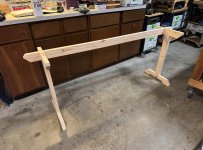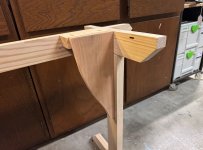I've been working on a simple pine base for a long, narrow table I'm making. The top is a 1.5" white oak slab that is 18" to 20" wide and eight feet long.
I've built this base out of pine that is 28" high with 15" upper crossmembers and 18" feet. The stretcher is six feet long. And there's a little racking.
I'm cutting domino mortises in the cross member and stretcher to hold metal mounting thing-a-ma-jiggies that screw into the top. My first time making something like this. Do I need to worry about the racking? Will screwing the top to the base eliminate that? Should I add another stretcher? If so, where is ideal?
I'm including a photo of the assembled base and a video of the racking.
Thanks!
[attachimg=1]
I've built this base out of pine that is 28" high with 15" upper crossmembers and 18" feet. The stretcher is six feet long. And there's a little racking.
I'm cutting domino mortises in the cross member and stretcher to hold metal mounting thing-a-ma-jiggies that screw into the top. My first time making something like this. Do I need to worry about the racking? Will screwing the top to the base eliminate that? Should I add another stretcher? If so, where is ideal?
I'm including a photo of the assembled base and a video of the racking.
Thanks!
[attachimg=1]





